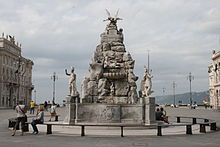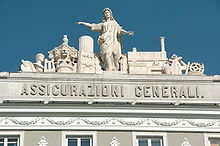Piazza dell'Unità d'Italia
The Piazza dell'Unità d'Italia ( German place of the unity of Italy ) is the main square of the northern Italian city of Trieste . As the largest square in the city, it is also known as the Piazza Grande .
location
The Piazza dell'Unità d'Italia is located in the center of Trieste at the foot of the San Giusto hill and connects the neighboring districts of Borgo Teresiano ( Theresienvorstadt ) and Borgo Giuseppino ( Josephsvorstadt ). Surrounded on three sides by neoclassical and some baroque buildings, the rectangular square borders on the fourth side directly on the Gulf of Trieste and is therefore one of the largest squares in Europe that is open to the sea.
Surname
Originally called Piazza San Pietro , due to the size of the square, the name Piazza Grande was popularly established at a very early stage and is still used today by the Trieste population. After the death of Emperor Franz Joseph I , it was named Piazza Francesco Giuseppe for a short time and after Trieste was linked to Italy in 1918, it was renamed Piazza Unità . On April 25, 1955, the mayor of Trieste, Gianni Bartoli , gave the square the official name Piazza dell'Unità d'Italia due to the difficult political situation in which Trieste found itself after the Second World War .
history
At the time of the Roman Empire there was still sea on the site of the square. Its origin can be traced back more or less to the silting up of the Roman port and the expansion of the city on the soil obtained in this way.
In the Middle Ages, the square was much smaller and more elongated within the fortification walls and was therefore not open to the sea.
At the end of the 18th century and at the beginning of the 19th century, the square changed radically. The appointment of Trieste as a free port in 1719 led to an enormous economic boom in the city and to rapid population growth. Space had to be made for the rapidly growing citizenry.
Since the city had already expanded beyond the old city walls, Karl's daughter Maria Theresa had them razed in 1749 and initiated the construction of the Borgo Teresiano ( Theresienvorstadt ) district on the drained salt pans at the gates of the city , which served as a new trading center. From this point on, the main square was replaced as a goods transfer point and increasingly served representative purposes. At around the same time as the city was expanding, the main square was expanded by grounding work.
The square got its present appearance at the end of the 19th century when most of the buildings surrounding it were rebuilt. The numerous magnificent buildings reflected the city's newly gained wealth.
In the 20th century, the Piazza dell'Unità d'Italia was the scene of numerous historical events such as the landing of the first Italian soldiers ( Bersaglieri ) in Trieste after the First World War , who were received to the cheers of a large part of the population.
Between 1999 and 2001 , the square was renovated and fitted with modern lighting.
Buildings
The main square is surrounded on three sides by neoclassical and some baroque buildings.
Palazzo del Municipio (City Hall)
The town hall Palazzo del Municipio (also Palazzo Comunale ) was designed between 1872 and 1875 by the architect Giuseppe Bruni in an eclectic style. The facade is heavily structured with narrowly lined up windows, round arches and half columns. The Louvre and the Scuola Grande di San Rocco in Venice served as architectural models . On the tower roof of the town hall are the two bronze statues Micheze e Jacheze (Italian Michele e Giacomo ) from 1517, which strike the tower clock every hour on the hour.
Palazzo Modello
Palazzo Modello was built by Giuseppe Bruni between 1871 and 1873 and was originally planned as an inn ( Locanda ). The five-axis corner building is an example of the eclectic historicism in Trieste: it combines elements from classical antiquity and the Italian Renaissance with medieval styles and the Baroque . The building was called the model palace because it was to serve as a model for the style of all other buildings on the square, the renovation of which began in 1870 and was completed around 1900. Except for the town hall, which was also designed by Bruni, all other buildings on the square were given their own architectural style.
Casa Stratti
The Casa Stratti 1839 to causing the Greek merchant Nicolò Stratti by architect Antonio Buttazzoni built. The facade of the building came from the architects Eugenio Geiringer and Domenico Righetti from 1872 and belonged to the late phase of Trieste classicism . Since its opening, the building has housed the renowned Caffè degli Specchi ( mirror café ) on the ground floor , where writers such as James Joyce and Rainer Maria Rilke have frequented. Since the original owner Nicolò Stratti was heavily in debt due to the immense construction costs, he sold the building in 1846 to the insurance company Assicurazioni Generali , which still owns it today.
Palazzo Pitteri
Palazzo Pitteri is the oldest building in the piazza. It was built in 1790 by the architect Ulderico Moro at the instigation of Domenico Plenario, a wealthy Trieste merchant . It was originally named Palazzo Plenario after its builder . The name of the palace was later changed in reference to its new owner, the Trieste writer Ricardo Pitteri (1853-1915). Today the building is owned by the insurance company Lloyd Adriatico . Palazzo Pitteri, together with the Fontana dei quattro continenti (1750) and a column (1728), is the only reminder of the 18th century.
Grand Hotel Duchi d'Aosta
The origins of the Grand Hotel Duchi d'Aosta go back to the 3rd century. In ancient times there was a Hospitium Magnum on the site of the current hotel , which was used to accommodate and entertain travelers. Between 1727 and 1732 the Hotel Osteria Grande was built on the site of the Hospitium Magnum and the current building. After numerous extensions and restorations in the 19th century, it was the largest hotel in the city and was renamed Locanda Grande . In 1847 the building was demolished. In its place, at the instigation of the landowner, the Assicurazioni Generali insurance company , today's hotel was built by the architect Eugenio Geiringer with French stylistic elements. Originally called Hotel Garni , it was renamed Palazzo Vanoli at the beginning of the 20th century . Although the official name of the building was changed to Hotel Duchi d'Aosta in 1972 in honor of the Dukes of Aosta , Trieste still call it Palazzo Vanoli today .
The hotel has hosted numerous well-known personalities since it was founded in the 18th century. Famous guests include Giacomo Casanova , Carlo Goldoni , Bob Dylan , Francis Ford Coppola , Ray Charles , Anthony Hopkins , Sting , Bryan Adams and Queen Nūr of Jordan .
The hotel is probably best known for the murder of Johann Joachim Winckelmann . The founder of scientific archeology was stabbed to death on June 8, 1768 in the rooms of the hotel by Francesco Arcangeli . Johann Gottfried Seume stayed here on his walk to Syracuse .
Palazzo del Lloyd Triestino
One of the later buildings on the square is Palazzo del Lloyd Triestino , which was designed in 1883 by Heinrich von Ferstel , the architect of the Votive Church in Vienna , in the style of the Italian Renaissance. Originally known as Palazzo del Lloyd Austriaco and owned by the shipping company Österreichischer Lloyd , the company and buildings were changed to Lloyd Triestino and Palazzo del Lloyd Triestino when Trieste was annexed to Italy in 1919 . Today the palace is the seat of the regional government. In the facade there are remarkable allegorical representations of fresh water on the left and sea water on the right.
Palazzo del Governo
The government palace Palazzo del Governo is the latest building on the Piazza dell'Unità d'Italia. It was built between 1901 and 1905 by the Viennese architect Emil Artmann and stands out from the rest of the buildings thanks to the colorful and golden mosaic stones that look oriental.
Fountain and column
In honor of Charles VI. , who made Trieste a free port, a column was erected by Fusconi on September 10, 1728 in the main square, which can still be seen today. It shows the Roman-German Emperor and Austrian Archduke, whose left hand points to the Old Port ( Porto Vecchio ). The originally wooden figure was replaced by a white stone statue by Lorenzo Fanoli on the occasion of the visit of Empress Maria Theresa in 1754.
In 1750 Giovanni Mazzoleni built the Fontana dei quattro continenti ( Fountain of the Four Continents ) on the Piazza Grande. The statues on the fountain represent the then four continents Europe, Asia, Africa and America. The fountain marked the end of the Acquedotto Teresiano aqueduct , which was built under Maria Theresa and supplied water to the newly created Borgo Teresiano commercial district . On the occasion of Benito Mussolini's visit in 1938, the fountain was moved to the city's lapidarium . It was not set up again until 1970 in the Piazza dell'Unità d'Italia.
The fountain and column, along with Palazzo Pitteri, are the only memories of the 18th century and form a baroque corner in the square.
literature
- Halupca, Armando / Veronese Leone (2006): Trieste nascosta - tra vie, androne e piazze: raccolta illustrata di curiosità della città e dintorni, 2nd edition (Lint), San Dorglio della Valle.
Remarks
- ↑ At Anno , the building description contained in the Allgemeine Bauzeitung 1883 No. 4 along with several draft drawings of the Lloydpalast can be viewed online.
Web links
Coordinates: 45 ° 39 ′ 0 ″ N , 13 ° 46 ′ 4.3 ″ E












